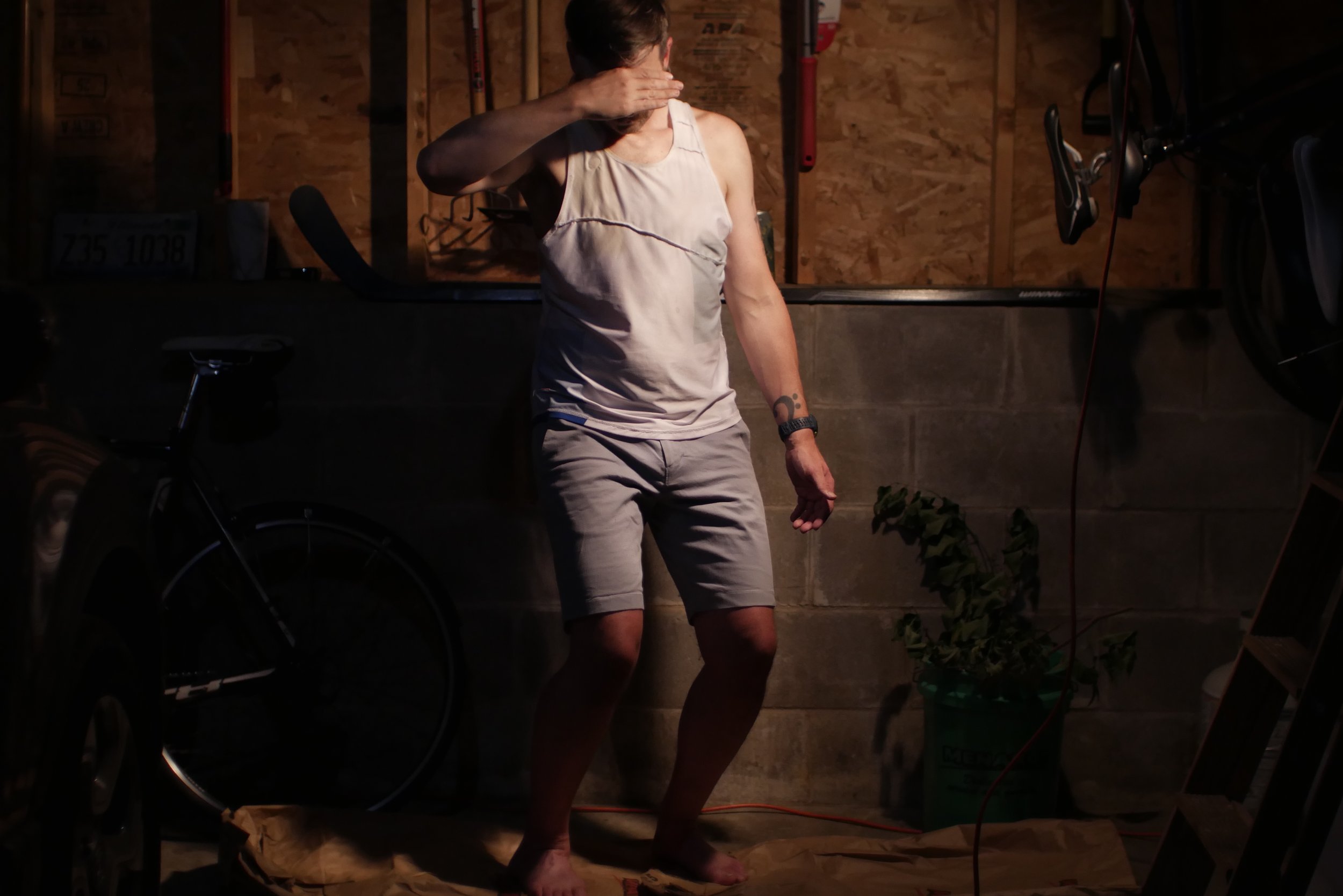Lite on Yoga
Upon celebrating a decade of vegetarianism and teaching the āsanas [June 2015 to present]
*Part 1: Tips and Cautions for the Practice of Āsanas
The requisites
i. Āsanas come easier after a divorce. You may begin a regular āsana practice prior to this, but it might not stick. The free classes (with your $9.99/mo membership) at the Rogers Park L.A. Fitness may conflict with your weekly Wal-Mart run. Use caution when scheduling āsana practice while the in-laws are visiting.
ii. Once the divorce is pending, the āsanas can begin in earnest. Practicing 6-12 times each week is not only acceptable, but is (in fact) expected.
Food and alcohol
iii. Any scotch consumption should conclude at least four hours prior to engaging in the 90-minute, 103oF morning sessions at your local Bikram studio. Importantly, the bowels must be fully evacuated prior to practicing the āsanas.
Cleanliness
iv. After completing the āsanas, the skin may glow like burnished copper but chafe like sandpaper. An odor of onion, cabbage, and peaty brown liquor will emanate from your underarms and between your thighs. Bathing with bar soap prior to work or any subsequent socialization is desirable.
Linguistics
v. If new to the āsana practice, you should familiarize yourself with the straining sing-song voice of the common yoga teacher. Some terminology to explore: juicy to describe a particularly challenging pose, kitten as a verb, and intention as a catch-all. Common phrases to research: “meet yourself where you are,” “set an intention for your practice,” and “everything is impermanent”.
Special warning for persons afflicted by detached retina or monkeypox
vi. Those suffering from detached retina or Monkeypox Virus should not attempt certain inverted poses, such as kakāsana (Plate 102).
Special provision for males
vii. Don’t be a creep.
Plate 102
Part 2: The Āsanas
viii. Essaÿāsana (Plate 103)
Essaÿ means “to try”. This pose resembles leaning on your creative writing skills to apply for a Yoga Teacher Training (YTT) scholarship.
Plate 103
Technique
Exhale as yet another customer tells you “you obviously don’t know how to do your job”.
Inhale while receiving a personal call from a number outside your area code.
Exhale and excuse yourself to the restroom.
Inhale as Courtney from Yoga Teacher Training congratulates you on winning the scholarship.
Feeling lighter and more limber already, return to your cubicle to find three new angry voicemails on your office answering machine. Exhale.
Effects
This pose massages the digestive organs. It temporarily cures depression but may encourage bouts of anxiety as you fret that your boss, Pamela, won’t let you off every Thursday for nine months to complete YTT.
ix. Daydreamāsana (Plate 104)
This pose resembles dreaming by daylight. Hence the name.
Plate 104
Technique
Sit on a park bench, ideally outdoors on your lunch break, but any seated position will do.
Inhaling, lightly close your eyes.
Contemplate the following question: “Why do I really want to be a yoga teacher?”
Think about the time when you callously ridiculed a male friend for driving around with a yoga mat in plain view in his backseat.
Contemplate the following question: “Do I really want to be a yoga teacher?”
Exhale. Silence your cell phone alarm and trudge back to the office you despise.
Effects
This āsana directs the flow of bile away from the back of the throat. It tones and shapes the amygdala.
x. Eka-Pāda Twoweekāsana (Plate 105)
Eka-Pāda means “upon one leg”. “Giving two weeks” is the Western practice of giving prior written notice prior to resigning your employment. Āsana, of course, means posture or pose. Taken together, this is resigning-on-one-leg pose.
Plate 105
Technique
Inhale deeply into the solar plexus.
Hold your breath as you stand on your left leg, opposite Pamela as she eats leftover Olive Garden in her office at the Illinois Department of Human Services.
Tell her: “I know we are severely understaffed at the moment, but I am hereby resigning so I can attend Yoga Teacher Training.”
Exhale fully as she smiles and confides that she’s really into couples’ ASMR massage and something called holographic memory retrieval.
Raise your eyebrows in acknowledgement.
Repeat 1-5 on the right leg.
Effects
This āsana lengthens and strengthens the spine. It controls and stills the mind. Relieves gastric troubles and flatulence. May result in a going-away party thrown by co-workers. May introduce constant fear of how to pay your bills.
“Your fist closes and opens,
and opens and closes.
If there was a sparrow on your palm
she would die.”
xi. Journalāsana
This posture—which must be presented to your guru daily—incorporates meditation, gratitude, assigned readings from a dozen textbooks, surface-level Sanskrit lessons, and reflections on your āsana practice.
Technique
Sit quietly and meditate for at least five minutes per day, 5-7 times per week. This can be done in a quiet bedroom, on the CTA red line towards the Loop, or in the waiting room of your state Unemployment Office. Write down whatever comes up for you.
Before closing your eyes for bed each day, write down three things that you are grateful for. Examples might include “finding a parking spot close to home on a late night,” “selling my guitars, books, and records for food money,” or “my sisters”
Read published books which contain lines like: “Don’t be a sage on a stage, be a guide by their side” and “make connections, not corrections.”
Effects
A decade in the future, after you’ve dug up your old journals, you’ll realize how often you had to decide between buying groceries or getting gas for your vehicle, thus triggering a modicum of sympathy for Past You.
xii. Yoga-mealāsana (Plate 109)
“Yoga-meal” is the prescribed way of taking your supper. This posture resembles the proper consumption of meals, hence the name.
Technique
Inhale as you lift a steaming forkful of pot roast to your lips.
Insert fork into your mouth and close the eyes, thus removing visual distraction. Commence chewing—slowly.
Exhale. Release your fork.
As you chew, give silent gratitude to every Being who touched your food before it arrived at its present destination—your tongue.
A) the Bovine Veterinarian—as appropriate—who helped birth the Calf B) the Cow, who fattened the Calf with her milk C) the Seasons, which gave life and nutrients to the pastures that fed the Calf D) the Rancher, who bailed hay and mended the fences, thus feeding and protecting the Calf E) the Trucker, who hauled the grown Calf to slaughter F) the Slaughterman G) the Butcher, who trimmed the meat and sliced it into tantalizing loin, shank, and chuck H) the Other Trucker, who hauled the refrigerated meats to the Piggly Wiggly, the SuperValu I) your Mom, who selected and paid for and seasoned and lovingly roasted the pot roast for hoursPick up your fork.
Repeat for every bite you take until your plate is clean.
Each yoga-mealāsana should take at least thirty minutes to finish.
Plate 109
Effects
This posture soothes the digestive organs. It massages the spleen and releases shockwaves of euphoria throughout the body.
Plate 110
xiii. Vipassanāsana (Plate 110)
Vipassana means “to see things as they really are”. It is an ancient style of meditation and also the name of a FREE ten-day-long silent meditation course.
Technique
Take ten days of vacation from your work. If unemployed or “self-employed,” this step may be omitted.
No distractions are allowed at any time during the course. This includes but is not limited to:
cell phones
computers
watches
personal CD players, cassettes, iPods, etc.
photographs
notebooks
reading books or magazines
playing cards or other games
You will observe Noble Silence for the duration. This obviously means no speaking at all during the ten days, but it also means:
no physical exertion, other than walking—please note this also means NO yoga
no physical contact with other students
no eye contact with other students (Plate 111)
no writing or passing of notes to other students
You must observe the six Noble Precepts during your stay:
to abstain from killing any being—directly or indirectly:
This means you will be eating a strict vegetarian diet while at the Vipassana center.
No outside food is allowed: this extends to insects and any arachnids which may be cohabitating your dorm room.
to abstain from stealing
to abstain from all sexual activity
to abstain from telling lies
to abstain from all intoxicants, including cigarettes, snuff, molly, and the kiddie-size bottles of Dewars which might be in your glove compartment in the parking lot.
In fact, the parking lot will be off-limits to all students for the duration of your stay.
to abstain from sleeping in high or luxurious beds (Plate 112)
Sit absolutely still on the floor (or in a simple, aluminum folding chair, if elderly or infirm). Next, focus only on the sensation of your breath moving in and out through the nostrils. Any intervening thoughts must be dismissed as you return again and again to the awareness of the sensation of breath. Any hip pain or lower back discomfort must be dismissed. All that matters is the breath.
Remain in this posture for 13-15 hours per day for ten straight days.
Plate 111
Effects
This posture brings pain upon unrivaled pain. With nowhere to physically escape to, and nothing to distract you from your unceasing stream of injurious thoughts, you may need to follow up with emergency care from a licensed mental health professional (though nobody at the Vipassana center will warn you about this during your stay). This posture also tickles the kidneys and tones the abdominal muscles. May unexpectedly herald a decade of vegetarianism.
Plate 112
xiv. Graduāsana (Plate 115)
“To graduate” means to satisfactorily complete a curriculum. This pose resembles the graduation from YTT, however, the student should bear in mind the words of Guru B.K.S. Iyengar “the study of yoga is not like the work for a diploma by someone desiring favorable results in a stipulated time…success in yoga only follows from constant practice.”
Technique
Upon completing your requirements and successfully leading a 45-minute flow for your teacher and fellow YTT students, the fitness club manager offers you a position teaching the 5:30am Vinyassa class on Mondays and Wednesdays for $20 per class (this is more than you make taking part in clinical drug trials at the local university, so you agree).
Don’t be surprised—at least at first—if it takes six to eight hours of prep and rehearsals to earn that $20 per taught class.
In time, you will make up to $25 per class and teach five or more classes per week. Because you can’t afford the upkeep and maintenance on your vehicle, it breaks down and you commute one hour by bicycle for each class.
In more time, you grow a following, regularly packing 40-50 yogis into your evening and weekend classes. They routinely shower you with compliments, confide in you their deepest secrets, and sing happy birthday to you annually.
Effects
Teaching yoga to wounded and traumatized military veterans kneads the brain and massages the lymphatic system. Offering free virtual yoga classes during the pandemic becomes your way of coping with the death and horror surrounding you. Eventually, as you return to the 40+ hour workforce, you don’t mind the meager yoga teacher compensation; instead, you think of your time as a gift back to the community that fostered your own āsana journey.
Plate 115
*with admiration for B.K.S. Iyengar’s seminal text: Light on Yoga










